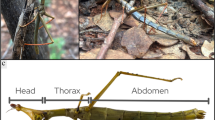Abstract
We found that the searching behavior of two acarine predators,Amblyseius fallacis andPhytoseiulus macropilis, for prey,Tetranychus urticae, is affected by the following stimuli: (1) prey silk and associated feces, whose combined physical and chemical properties elicit reduction in the rate of predator movements and longer halts; (2) kairomone extracted from prey silk and associated feces, which, upon contact, elicits frequent predator return to prey-inhabited locales; and (3) predator-emitted marking pheromone, which elicits shorter duration of search in presearched prey locales. We also found that treatment of filter paper with prey kairomone or silk enhanced predator location of prey eggs, leading us to speculate that application of synthetic prey kairomone could be useful in pest management programs.
Similar content being viewed by others
References
Ballard, R.C. 1954. The biology of the predacious miteTyphlodromus fallacis (Garman) (Phytoseiidae) at 78 ° F.Ohio J. Sci. 54(3):175–179.
Blommers, L., Lobbes, P., Vink, P., andWegdam, F. 1977. Studies on the response ofAmblyseius bibens (Acarina: Phytoseiidae) to conditions of prey scarcity.Entomophaga 22(3):247–258.
Brunner, J.F., andBurts, E.C. 1975. Searching behavior and growth rates ofAnthocaris nemoralis (Hemiptera: Anthocoridae), a predator of the pear psylla,Psylla pyricola.Ann. Entomol Soc. Am. 68(2):311–315.
Croft, B.A. 1975. Integrated control of apple mites. Extension Bull. C-825, Mich. St. Univ. Ext. Ser. 12 pp.
Croft, B.A., andNelson, E.E. 1972. Toxicity of apple orchard pesticides to Michigan populations ofAmblyseius fallacis.Environ. Entomol. 2:576–579.
Elsey, K.D. 1974. Influence of plant host on searching speed of two predators.Entomophaga 19(1):3–6.
Evans, H.F. 1976. The searching behaviour ofAnthocaris confusis (Reuter) in relation to prey density and plant surface topography.Ecol. Entomol. 1:163–169.
Farish, D.J., andAxtell, R.C. 1966. Sensory functions of the palps and first tarsi ofMacrocheles muscaedomesticae (Acarina: Macrochelidae), a predator of the house fly.Ann. Entomol Soc. Am. 59(1):165–170.
Greany, P.D., andHagen, K.S. 1981. Role and significance of allelochemics in prey selection, pp. 89–95,in D.A. Nordlund, R.L. Jones, and W.J. Lewis (eds.). Semiochemicals: Their Role in Pest Control, John Wiley & Sons, New York.
Hagen, K.S., Sawall, E.F., Jr., andTassan, R.L. 1970. The use of food sprays to increase effectiveness of entomophagous insects.Proc. Tall Timb. Conf, on Ecol. Anim. Cont. by Habit. Manag. 2:59–81.
Hamlen, R.A. 1978. Biological control of spider mites on greenhouse ornamentals using predaceous mites.Proc. Fla. State Hort. Soc. 91:247–249.
Hamlen, R.A. 1980. Report ofPhytoseiulus macropilis management ofTetranychus urticae on greenhouse grown dieffenbachia.Bull. IOBC/ WPRS 111/3:65–73.
Henderson, D.F., andMcBurnie, H.V. 1943. Sampling technique for determining populations of the citrus red mite and its predators. USDA Circ. 671. 11 pp.
Hislop, R.G., andProkopy, R.J. 1981. Integrated management of phytophagous mites in Massachusetts (USA) apple orchards: (2). Influence of pesticides on the predatorAmblyseius fallacis (Acarina: Phytoseiidae) under laboratory and field conditons.Prot. Ecol. In press.
Jalil, M.,andRodriguez, J.G. 1970. Studies of the behavior ofMacrocheles muscaedomesticae (Acarina: Macrochelidae) with emphasis on its attraction to the house fly.Ann. Entomol. Soc. Am. 63(3):738–744.
Johnson, D.T., andCroft, B.A. 1976. Laboratory study of the dispersal behavior ofAmblyseius fallacis (Acarina: Phytoseiidae).Ann. Entomol. Soc. Am. 69(6):1019–1023.
Kennedy, J. S. 1977. Olfactory responses to distant plants and other odor sources, pp. 67–91,in H.H. Shorey, J.J. McKelvey (eds.), Chemical Control of Insect Behavior, John Wiley & Sons, New York.
Lewis, W.J., Jones, R.L., andSparks, A.N. 1972. A host-seeking stimulant for the egg parasite,Trichogramma evanescens: Its source and a demonstration of its laboratory and field activity.Ann. Entomol Soc. Am. 65:1087–1089.
Lewis, W.J., Nordlund, D.A., Gross, H.R., Jr., Jones, R.L., andJones, S.L. 1977. Kairomones and their use for management of entomophagous insects V. moth scales as a stimulus for predation ofHeliothis zea (Boddie) eggs byChrysopa cornea Stephens larvae.J. Chem. Ecol. 3(4):483–487.
Marks, R.J. 1977. Laboratory studies of plant searching behaviour byCoccinella septempunctata L. larvae.Bull. Entomol. Res. 67:235–241.
McClanahan, R.J. 1968. Influence of temperature on the reproductive potential of two mite predators of the two-spotted spider mite.Can. Entomol. 100:549–556.
McLain, K. 1979. Terrestrial trail following by three species of predatory stink bugs.Fla. Entomol. 62:152–154.
Mori, H., andChant, D.A. 1966. The influence of prey density, relative humidity, and starvation on the predacious behavior ofPhytoseiulus persimilis Athias-Henriot (Acarina: Phytoseiidae).Can. J. Zool. 44:483–491.
Motoyama, N., Rock, G.C., andDauterman, W.C. 1970. Organophosphorous resistance in an apple orchard population ofTyphlodromus (Amblyseius) fallacis.J. Econ. Entomol. 63(5):1439–1442.
Ohnesorge, B. 1978. Der Einfluss der Besiedlungsdauer spinnmilbenverseuchter Bohnenblätter auf die raümuliche Verteilung der RaubmilbePhytoseiulus persimilis A. and H. (Acarina, Phytoseiidae).Z. Angew. Entomol. 85:337–340.
Prasad, V. 1967. Biology of the predatory mitePhytoseiulus macropilis in Hawaii (Acarina: Phytoseiidae).Ann. Ent. Soc. Am. 60:905–908.
Prokopy, R.J. 1981. Epideictic pheromones influencing spacing patterns of phytophagous insects, pp. 181–213,in D.A. Nordlund, R.L. Jones, and W.J. Lewis (eds.). Semiochemicals: Their Role in Pest Control. John Wiley & Sons, New York.
Rasmy, A.H., andEl-Banhawy, E.M. 1974. Behaviour and bionomics of the predatory mite,Phytoseius plumifer (Acarina: Phytoseiidae) as affected by physical surface features of host plants.Entomophaga 19(3):255–257.
Rock, G.C., Monroe, R.J., andYeargan, D.R. 1976. Demonstration of a sex pheromone in the predaceous miteNeoseiulus fallacis.Environ. Entomol. 5(2):264–266.
Rowlands, M.L.J., andChapin, J.W. 1979. Prey searching behavior in adults ofHippodamia convergens (Coleoptera: Coccinellidae).J. Ga. Entomol. Soc. 13(4):309–315.
Schmidt, G. 1976. Der Einfluss der von den Beutetieren hinterlassenen Spuren auf Suchverhalten und Sucherfolg vonPhytoseiulus persimilis A. and H. (Acarina: Phytoseiidae).Z. Angew. Entomol. 82:216–218.
Shih, C.I., Poe, S.L., andCromroy, H.L. 1979. Biology and predation ofPhytoseiulus macropilis onTetranychus urticae.Fla. Ent. 62:48–53.
Smith. J.C. andNewsom, L.D. 1970a. The biology ofAmblyseius fallacis (Acarina: Phytoseiidae) at various temperature and photoperiod regimes.Ann. Entomol. Soc. Am. 63(2):460–462.
Smith, J.C., andNewsom, L.D. 1970b. Laboratory evaluation ofAmblyseius fallacis as a predator of tetranychid mites.J. Econ. Entomol. 63(6):1876–1878.
Vinson, S.B. 1976. Host selection by insect parasitoids.Annu. Rev. Entomol. 21:109–133.
Weseloh, R.M. 1980. Behavioral changes inApanteles melanoscelus females exposed to Gypsy Moth silk.Environ. Entomol. 9:345–349.
Wilbert, H. 1974. Die Wahrnehmung von Beute durch die Eilarven vonAphidoletes aphidimyza (Cecidomyiidae).Entomophaga 19(2):173–181.
Author information
Authors and Affiliations
Rights and permissions
About this article
Cite this article
Hislop, R.G., Prokopy, R.J. Mite predator responses to prey and predator-emitted stimuli. J Chem Ecol 7, 895–904 (1981). https://doi.org/10.1007/BF00992387
Received:
Revised:
Issue Date:
DOI: https://doi.org/10.1007/BF00992387




